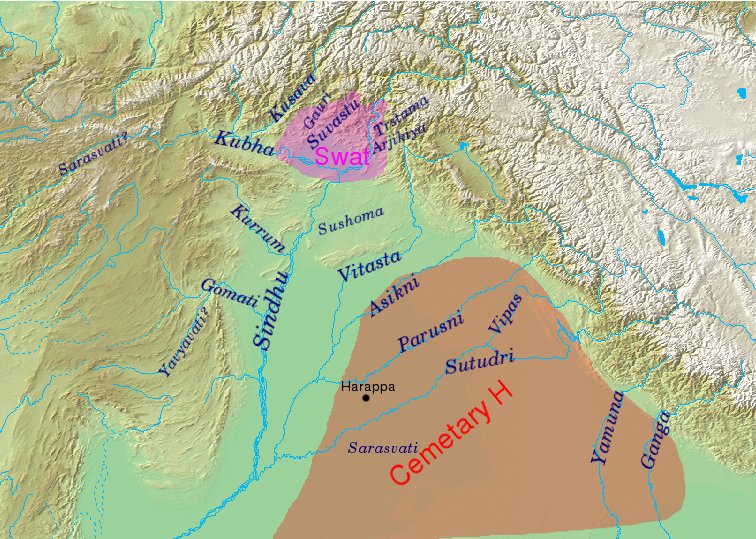|
Barikot
Barikot () (Pashto: بریکوټ) is a town located in the middle course of the Swat River in Khyber Pakhtunkhwa, Pakistan. It is located about away from Mingora and the Butkara Stupa. It is the entrance town to the central Swat Valley with a population of approximately 25,000 people. Barikot is the location of an ancient citadel captured by Alexander the Great, Archaeological site notice with Chalcolithic remains dating back to ,Olivieri, Luca M., 2012. "When and why the ancient town of Barikot was abandoned?: A preliminary note based on the last archaeological data", in Pakistan Heritage 4, Table 1, and p. 111. and an early-historic period town dating back to .Olivieri, Luca Maria, & Anna Filigenzi, 201"On Gandharan sculptural production from Swat: Recent archaeological and chronological data" in W. Rienjang and P. Stewart (eds.), Problems of Chronology in Gandharan Art: Proceedings of the First International Workshop of the Gandhara Connections Project, p. 71. The Italian Arc ... [...More Info...] [...Related Items...] OR: [Wikipedia] [Google] [Baidu] |
Barikot Tehsil
Barikot is an administrative subdivision (tehsil) of Swat District in the Khyber Pakhtunkhwa province of Pakistan. Swat District has seven tehsils i.e. Tehsil Barikot, Tehsil Babuzai, Tehsil Matta, Tehsil Khwazakhela, Tehsil Kabal, Tehsil Charbagh and Tehsil Bahrain. Each Tehsil comprises certain numbers of Union council. There are 65 Union council in district Swat (56 rural and 09 urban). According to Khyber Pakhtunkhwa Local Government Act 2013, Tehsil Barikot has the following 5 Wards: # Ghalegay # Barikot # Tindodag # Panjigram # Najigram # Nawagai # Amlok Dara # Karakar # Kandak Jehangir # Parrai # Kota # Shamozai # Guratai # Manyar # Landakay # New kalai # Shingardar # Nagoha # Dedawar # zarakhela # Chungi See also *Swat District Swat District (), also known as the Swat Valley, is a Districts of Pakistan, district in the Malakand Division of Khyber Pakhtunkhwa, Pakistan. Known for its stunning natural beauty, the district is a popular tourist destinati ... [...More Info...] [...Related Items...] OR: [Wikipedia] [Google] [Baidu] |
Swat Valley
Swat District (), also known as the Swat Valley, is a district in the Malakand Division of Khyber Pakhtunkhwa, Pakistan. Known for its stunning natural beauty, the district is a popular tourist destination. With a population of 2,687,384 per the 2023 national census, Swat is the 15th-largest district of Khyber Pakhtunkhwa. Swat District is centred on the Valley of Swat, usually referred to simply as Swat, which is a natural geographic region surrounding the Swat River. The valley was a major centre of early Buddhism of the ancient civilisation of Gandhara, mainly Gandharan Buddhism, with pockets of Buddhism persisting in the valley until the 16th century conquest of Swat by the Yousafzais, after which the area became largely Muslim, along with the Pashtunization of Swat and its neighbouring regions. In the early 19th century, Swat emerged as an independent state under Saidu Baba. State of Swat became a Princely state under British suzerainty as part of the British Raj ... [...More Info...] [...Related Items...] OR: [Wikipedia] [Google] [Baidu] |
Swat District
Swat District (), also known as the Swat Valley, is a Districts of Pakistan, district in the Malakand Division of Khyber Pakhtunkhwa, Pakistan. Known for its stunning natural beauty, the district is a popular tourist destination. With a population of 2,687,384 per the 2023 Pakistani census, 2023 national census, Swat is the 15th-largest district of Khyber Pakhtunkhwa. Swat District is centred on the Valley of Swat, usually referred to simply as Swat, which is a natural geographic region surrounding the Swat River. The valley was a major centre of early Buddhism of the ancient civilisation of Gandhara, mainly Gandharan Buddhism, with pockets of Buddhism persisting in the valley until the 16th century Sultanate of Swat, conquest of Swat by the Yousafzais, after which the area became largely Muslim, along with the Pashtunization of Swat and its neighbouring regions. In the early 19th century, Swat emerged as an independent state under Saidu Baba. State of Swat became a Princely stat ... [...More Info...] [...Related Items...] OR: [Wikipedia] [Google] [Baidu] |
Gandhara Grave Culture
The Gandhara grave culture of present-day Pakistan is known by its "protohistoric graves", which were spread mainly in the middle Swat River valley and named the Swat Protohistoric Graveyards Complex, dated in that region to –800 BCE. The Italian Archaeological Mission to Pakistan (MAIP) holds that there are no burials with these features after 800 BCE. More recent studies by Pakistani scholars, such as Muhammad Zahir, consider that these protohistoric graves extended over a much wider geography and continued in existence from the 8th century BCE until the historic period. The core region was in the middle of the Swat River course and expanded to the valleys of Dir, Kunar, Chitral, and Peshawar. Protohistoric graves were present in north, central, and southern Khyber Pakhtunkhwa province as well as in north-western tribal areas, including Gilgit-Baltistan province, Taxila, and Salt Range in Punjab, Pakistan, along with their presence in Indian Kashmir, Ladakh, and Uttarak ... [...More Info...] [...Related Items...] OR: [Wikipedia] [Google] [Baidu] |
Butkara Stupa
The Butkara Stupa (Pashto: بت کړه سټوپا) is an important Buddhist stupa near Mingora, in the area of Swat, Pakistan. It may have been built by the Mauryan emperor Ashoka, but it is generally dated slightly later to the 2nd century BCE. The stupa was enlarged on five occasions during the following centuries, every time by building over, and encapsulating, the previous structure. Excavation The stupa was excavated by an Italian mission (IsIOAO: Istituto Italiano per l'Africa e l'Oriente), led by archaeologist Domenico Faccenna from 1956, to clarify the various steps of the construction and enlargements. The mission established that the stupa was "monumentalized" by the addition of Hellenistic architectural decorations during the 2nd century BCE, suggesting a direct involvement of the Indo-Greeks, rulers of northwestern India during that period, in the development of Greco-Buddhist architecture. An Indo-Corinthian capital representing a Buddhist devotee within foli ... [...More Info...] [...Related Items...] OR: [Wikipedia] [Google] [Baidu] |
Aśvaka
Asvakas (Sanskrit language, Sanskrit: Aśvaka) were an ancient people from Gandhara in the present-day Pakistan and Afghanistan. The region in which they lived was also called ''Aśvaka''. Etymology The Sanskrit term ''aśva'', Prakrit ''assa'' and Avestan ''aspa'' means horse. The name ''Aśvaka''/''Aśvakan'' or ''Assaka'' is derived from the Sanskrit ''Aśva'' or Prakrit ''Assa'' and it denotes someone connected with the horses, hence a horseman, or a cavalryman. The Asvakas were especially engaged in the occupation of breeding, raising and training Horses in warfare, war horses, as also in providing expert cavalry services. The name of the ''Aśvakan'' or ''Assakan'' is believed by some scholars to have been preserved in that of the modern Pashtun, with the name Afghan (ethnonym), Afghan being derived from Asvakan. Ethnology In the Major Rock Edicts of Ashoka, Asvakas are described as Gandhari people, Gandhāras (Gandharians) Adapted from who are recorded separately from ... [...More Info...] [...Related Items...] OR: [Wikipedia] [Google] [Baidu] |
Swat River
The Swat River (, ) is a perennial river in the northern region of the Khyber-Pakhtunkhwa Province of Pakistan. The river's source is in the high glacial valleys of the Hindu Kush mountains, where it then flows into the Kalam Valley before forming the spine of the wider Swat Valley. Name The word Swat comes from the Sanskrit name ''Suvāstu'' which may mean "clear blue water." Another theory derives the word Swat from the Sanskrit word ''shveta'' (), also used to describe the clear water of the Swat River. To the ancient Greeks, the river was known as the ''Soastus.'' The Chinese pilgrim Faxian referred to Swat as the ''Su-ho-to''. Course The Swat's source lies in the Hindu Kush mountains, from where it is fed by glacial waters throughout the year. From the high valleys of Swat Kohistan, the river begins at the confluence of the Usho, and Gabral rivers (also known as the Utrar River) at Kalam. From the confluence, the Swat river flows through the narrow gorges of the Kalam ... [...More Info...] [...Related Items...] OR: [Wikipedia] [Google] [Baidu] |
Giuseppe Tucci
Giuseppe Tucci (; 5 June 1894 – 5 April 1984) was an Italian orientalist, Indologist and scholar of East Asian studies, specializing in Tibetan culture and the history of Buddhism. During its zenith, Tucci was a supporter of Italian fascism, and he used idealized portrayals of Asian traditions to support Italian ideological campaigns. Tucci was fluent in several European languages, Sanskrit, Bengali, Pali, Prakrit, Chinese and Tibetan and he taught at the University of Rome La Sapienza until his death. He is considered one of the founders of the field of Buddhist studies. Life and work Education and background He was born to a middle-class Italian family (from Apulia) in Macerata, Marche, and thrived academically. He taught himself Hebrew, Chinese and Sanskrit before even going to university and in 1911, aged only 18, he published a collection of Latin inscriptions in the prestigious '' Zeitschrift des Deutschen Archäologischen Instituts''. He completed his studies at ... [...More Info...] [...Related Items...] OR: [Wikipedia] [Google] [Baidu] |





